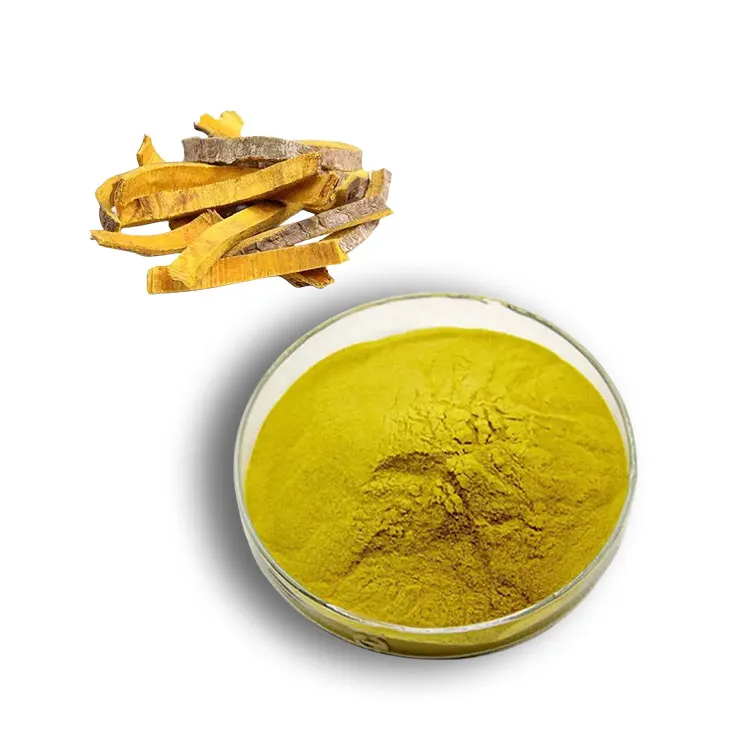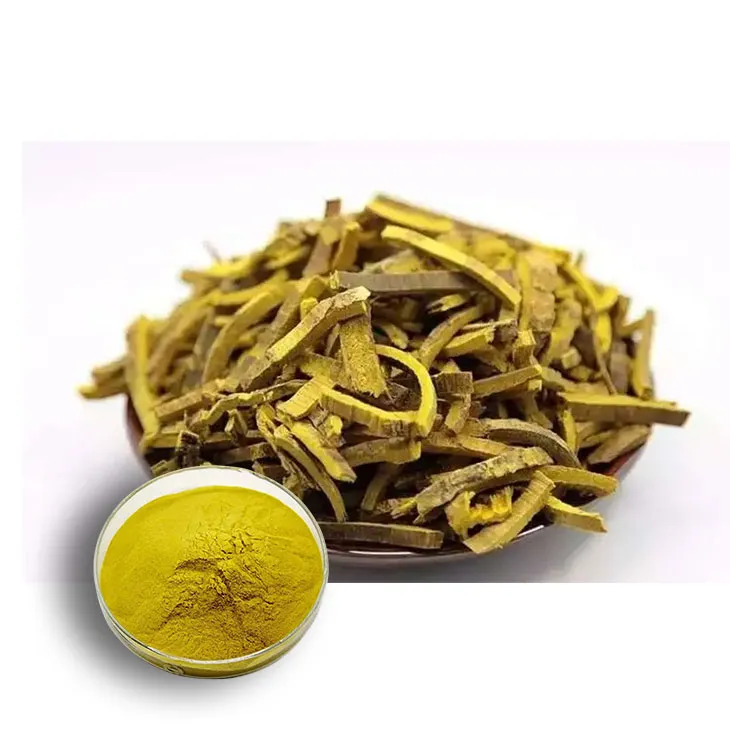- 0086-571-85302990
- sales@greenskybio.com
Best Answers to 7 Key Questions about Phellodendron Extract.
2024-12-21

1. What is the origin of Phellodendron amurense?
Phellodendron amurense, also known as Amur cork - tree, is native to parts of Asia, particularly in regions of China, Korea, and Russia. It typically grows in forested areas, often in mountainous regions with well - drained soil and a certain level of humidity. In China, it can be found in the northeastern provinces. The tree is well - adapted to the local climate conditions in these areas, which play an important role in the formation of its unique properties.

2. What are the physical and chemical properties of Phellodendron amurense extract?
Physical properties: - Phellodendron amurense extract is often a brownish - yellow to dark - brown powder or liquid, depending on the extraction method. - It has a characteristic odor that is somewhat earthy and bitter. Chemical properties: - The extract contains a variety of bioactive compounds. One of the main components is berberine, which is a type of alkaloid. Berberine has been widely studied for its pharmacological activities. - It also contains other alkaloids, flavonoids, and phenolic compounds. These components contribute to its antioxidant, anti - inflammatory, and antimicrobial properties.

3. How is Phellodendron amurense extract prepared?
The extraction of Phellodendron amurense extract generally involves the following steps:
- Collection of raw materials: First, the bark of Phellodendron amurense is carefully collected. This should be done in a sustainable way to ensure the long - term survival of the tree. The collected bark is then cleaned to remove any impurities such as dirt, debris, or other foreign matter.
- Drying: After cleaning, the bark is dried. This can be done through natural drying in a well - ventilated area or using artificial drying methods at a controlled temperature. Drying helps to reduce the moisture content of the bark, which is important for subsequent extraction steps.
- Extraction: There are several extraction methods available. One common method is solvent extraction. Organic solvents such as ethanol or methanol can be used to extract the bioactive compounds from the dried bark. The solvent is mixed with the bark in a suitable ratio and then allowed to stand for a period of time to allow the compounds to dissolve into the solvent. Another method is supercritical fluid extraction, which uses supercritical carbon dioxide as the extraction agent. This method has the advantage of being more environmentally friendly and can produce a higher - quality extract.
- Concentration and purification: After extraction, the resulting solution contains the extract along with the solvent. The solvent is then removed through evaporation or other concentration methods to obtain a more concentrated extract. Purification steps may also be carried out to remove any remaining impurities or unwanted compounds, resulting in a purer Phellodendron amurense extract.

4. What are the main health benefits of Phellodendron amurense extract?
Antimicrobial activity: - Phellodendron amurense extract, mainly due to the presence of berberine and other bioactive compounds, has been shown to have antimicrobial effects against a variety of bacteria, fungi, and viruses. For example, it can inhibit the growth of Escherichia coli, Staphylococcus aureus, and Candida albicans. This makes it potentially useful in the treatment of infectious diseases. Anti - inflammatory properties: - The extract can reduce inflammation in the body. It may act by inhibiting the production of inflammatory mediators such as cytokines and prostaglandins. This anti - inflammatory effect can be beneficial for conditions such as arthritis, where inflammation in the joints is a major problem. Antioxidant effects: - The flavonoids and phenolic compounds in the extract act as antioxidants. They can scavenge free radicals in the body, which are unstable molecules that can cause damage to cells and tissues. By reducing oxidative stress, Phellodendron amurense extract may help prevent chronic diseases such as cancer, heart disease, and neurodegenerative diseases. Blood sugar regulation: - Some studies suggest that Phellodendron amurense extract may help regulate blood sugar levels. It may improve insulin sensitivity and reduce glucose absorption in the intestines, which could be beneficial for people with diabetes or at risk of developing diabetes.

5. Are there any potential side effects of Phellodendron amurense extract?
While Phellodendron amurense extract has many potential health benefits, there are also some potential side effects to be aware of:
- Gastrointestinal issues: In some cases, high doses of the extract may cause gastrointestinal discomfort such as nausea, vomiting, or diarrhea. This may be due to the bitter nature of the extract or its effects on the digestive system.
- Allergic reactions: Although relatively rare, some individuals may be allergic to Phellodendron amurense extract. Allergic symptoms can include skin rashes, itching, or swelling.
- Drug interactions: Phellodendron amurense extract may interact with certain medications. For example, it may interfere with the absorption or metabolism of drugs. People taking prescription medications should consult their healthcare provider before using the extract.
6. How is Phellodendron amurense extract used in traditional medicine?
In traditional Chinese medicine (TCM), Phellodendron amurense has a long history of use:
- Treating damp - heat syndromes: It is often used to treat conditions associated with damp - heat in the body, such as certain types of skin diseases, urinary tract infections, and digestive disorders. The theory in TCM is that it can clear heat and remove dampness from the body.
- As an anti - inflammatory agent: It has been used topically for treating inflammation - related skin problems like eczema and psoriasis. It is also used internally for reducing inflammation in the body, for example, in cases of joint inflammation.
- For detoxification: Phellodendron amurense is considered to have detoxifying properties in TCM. It is used to help the body eliminate toxins, which may improve overall health.
7. What are the current research trends and future prospects of Phellodendron amurense extract?
Current research trends: - There is an increasing focus on the pharmacological mechanisms of Phellodendron amurense extract. Researchers are trying to better understand how the various bioactive compounds in the extract interact with the body's cells and molecules to produce their health - promoting effects. - Studies are also being conducted on the potential use of the extract in combination with other drugs or natural products. For example, combining it with other antimicrobial agents to enhance its antibacterial or antifungal effects. - There is interest in developing more efficient and sustainable extraction methods to obtain high - quality Phellodendron amurense extract. Future prospects: - With the growing interest in natural products for health and wellness, Phellodendron amurense extract has the potential to be developed into a variety of health products, such as dietary supplements, functional foods, and herbal medicines. - It may also find applications in the field of cosmetology, for example, in the development of anti - inflammatory and antioxidant skin - care products. However, more research is needed to fully explore these potential applications and to ensure the safety and efficacy of the extract in different forms.
FAQ:
Question 1: What is the origin of Phellodendron amurense extract?
Phellodendron amurense is mainly native to regions in Asia, such as China, Korea, and parts of Russia. The extract is obtained from this plant. It is typically sourced from the bark of the Phellodendron amurense tree. Through careful extraction processes, the valuable components are isolated for various uses.
Question 2: What are the main properties of Phellodendron amurense extract?
It has several notable properties. It often contains alkaloids, flavonoids, and other bioactive compounds. These components give it antioxidant properties, which can help combat oxidative stress in the body. It may also have anti - inflammatory effects, potentially helping to reduce inflammation at the cellular level. Additionally, it has been studied for its antibacterial and antifungal activities in some cases.
Question 3: What are the common applications of Phellodendron amurense extract?
In traditional medicine, it has been used for treating various ailments such as digestive disorders, skin problems, and some types of fevers. In modern applications, it is being explored in the field of natural health products. It may be used in dietary supplements due to its potential health - promoting properties. Some skincare products also incorporate it for its possible anti - inflammatory and antioxidant benefits for the skin.
Question 4: Is Phellodendron amurense extract safe for consumption?
When used in appropriate amounts, it is generally considered safe for most people. However, like many natural extracts, it may cause adverse reactions in some individuals. People with certain allergies or sensitivities may experience issues such as skin rashes or digestive discomfort. Pregnant and breastfeeding women should be especially cautious and consult a healthcare provider before using products containing this extract.
Question 5: How is Phellodendron amurense extract produced?
The production process typically starts with the collection of the bark from Phellodendron amurense trees in a sustainable manner. Then, the bark is dried and ground into a fine powder. This powder can be subjected to solvent extraction methods, using solvents like ethanol or water - ethanol mixtures. After extraction, the solvent is removed, leaving behind the concentrated extract which may then be further purified and standardized for quality control.
Question 6: Are there any side effects associated with Phellodendron amurense extract?
As mentioned before, some people may experience side effects. These can include allergic reactions, which may manifest as skin itching, swelling, or hives. Ingesting large amounts may also lead to digestive problems such as nausea, vomiting, or diarrhea. Long - term use or overuse may potentially have effects on liver or kidney function, although more research is needed in this area.
Question 7: How does Phellodendron amurense extract compare to other plant extracts?
Compared to other plant extracts, Phellodendron amurense extract has its unique combination of bioactive compounds. While some other plant extracts may also have antioxidant or anti - inflammatory properties, the specific alkaloids and flavonoids in Phellodendron amurense extract give it a distinct profile. For example, compared to some common herbal extracts like ginseng, it has different mechanisms of action and potential applications. Ginseng is often more associated with energy - boosting and adaptogenic properties, while Phellodendron amurense extract is more focused on anti - inflammatory and antibacterial aspects among others.
Related literature
- The Chemical Constituents and Biological Activities of Phellodendron amurense: A Review"
- "Phellodendron amurense Extract in Traditional and Modern Medicine"
- "A Comprehensive Study on the Properties and Applications of Phellodendron amurense Bark Extract"
- ▶ Hesperidin
- ▶ Citrus Bioflavonoids
- ▶ Plant Extract
- ▶ lycopene
- ▶ Diosmin
- ▶ Grape seed extract
- ▶ Sea buckthorn Juice Powder
- ▶ Fruit Juice Powder
- ▶ Hops Extract
- ▶ Artichoke Extract
- ▶ Mushroom extract
- ▶ Astaxanthin
- ▶ Green Tea Extract
- ▶ Curcumin
- ▶ Horse Chestnut Extract
- ▶ Other Product
- ▶ Boswellia Serrata Extract
- ▶ Resveratrol
- ▶ Marigold Extract
- ▶ Grape Leaf Extract
- ▶ New Product
- ▶ Aminolevulinic acid
- ▶ Cranberry Extract
- ▶ Red Yeast Rice
- ▶ Red Wine Extract
-
Passionflower Extract
2024-12-21
-
Plantain extract
2024-12-21
-
Sea buckthorn oil
2024-12-21
-
Feverfew Extract
2024-12-21
-
Centella Asiatica Extract
2024-12-21
-
Curcuma Longa Extract/Turmeric extract
2024-12-21
-
Kelp Extract Powder
2024-12-21
-
Chia Seed Powder
2024-12-21
-
Lycopene
2024-12-21
-
Curcumin Extract
2024-12-21





















